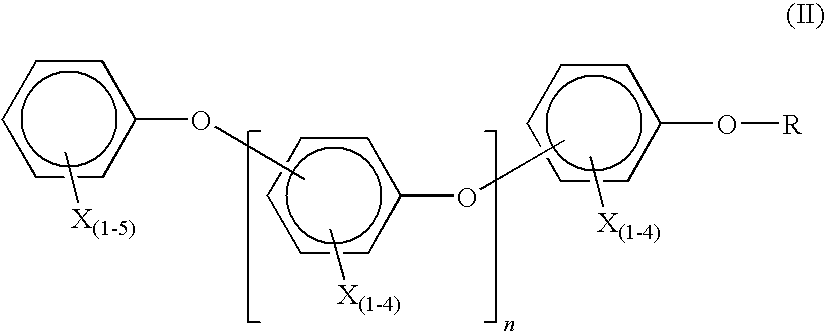Brominated flame retardant
a flame retardant and brominated technology, applied in the field of brominated flame retardants, can solve the problems of affecting the polymer properties, not practical industrially, component parts sometimes forming bubbles, etc., and achieves improved blister resistance, improved thermal stability, and improved polymer compatibility.
- Summary
- Abstract
- Description
- Claims
- Application Information
AI Technical Summary
Benefits of technology
Problems solved by technology
Method used
Image
Examples
example 1
Thermal Stability of Various Flame Retardant Materials
[0059]The thermal stability of the flame retardant materials of the current invention as made by the tetrahydrofuran process of Comparative Process 5, above, is shown in Table 3 (Compound 2). The thermal stability is measured by the mass loss rate (MLR) at 330° C. in an isothermal thermogravimetric analysis (“TGA”) experiment over 20 minutes. Lower mass loss rate values represent increased thermal stability. Compound 2, made by the process of the current invention is compared with polybromoaryl ether made by the aqueous process of Comparative Process 1 (Compound 1), a tribromophenol polymer (such as that marketed under the trade name Uniplex FRP-64P (“FRP-64P”)) and a brominated polystyrene-type flame retardant (“BPS”) (such as that marketed under the trade name Saytex 3010). Compound 2 has the lowest mass loss rate MLR value and therefore the highest thermal stability of the flame retardant materials compared.
[0060]
TABLE 3Therma...
example 2
Thermal Stability of Polyamide Formulations Containing Various Flame Retardant Materials
[0062]The thermal stability of the flame retardant materials in a 30 percent glass-reinforced PA6T / 66 polyamide formulation is shown in Table 4. The data show the improvement in the overall thermal stability of formulations using the Compound 2, prepared by the process of the current invention. The data in Table 4 confirm the Mass Loss Rate data discussed above for the Neat Flame Retardant Compounds. The formulation containing Compound 2, prepared by the process of the current invention, has the lowest value and therefore the highest thermal stability of the flame retardant materials compared.
[0063]
TABLE 4Thermal Stability of 30 Percent Glass Reinforced PA 6T / 66Formulations by Isothermal TGAFlame Retardant Usedin FormulationCompound 2FRP-64PBPSFormulation0.0700.2170.120Mass Loss Rate(% / min) @330° C.
[0064]Table 5 presents mass loss rate data for flame retardants tested in a 30 percent glass reinfo...
example 3
Blister Resistance of High Temperature Polyamide Formulations Using Polybromoaryl Ether as the Flame Retardant
[0069]In many connector applications involving surface-mount technology, the use of lead-free solder results in higher processing temperatures. This use sometimes results in polyamide parts forming blisters on the surface. The use of the flame retardant compound of the current invention improves the blister performance as shown in Table 6.
[0070]The blister resistance was determined by exposing the molded part to high levels of humidity for a specified period of time and then passing the specimen through a solder reflow oven using different peak reflow temperatures at 5° C. increments. The reflow oven temperature profile is based on what is described in the IPC / JEDEC J-STD-020C joint industry standard. The blister resistance temperature was noted as the highest temperature at which no blisters formed. The formulations containing Compound 2 show an improvement in blister resis...
PUM
| Property | Measurement | Unit |
|---|---|---|
| wt % | aaaaa | aaaaa |
| mol % | aaaaa | aaaaa |
| molecular weight | aaaaa | aaaaa |
Abstract
Description
Claims
Application Information
 Login to View More
Login to View More - R&D Engineer
- R&D Manager
- IP Professional
- Industry Leading Data Capabilities
- Powerful AI technology
- Patent DNA Extraction
Browse by: Latest US Patents, China's latest patents, Technical Efficacy Thesaurus, Application Domain, Technology Topic, Popular Technical Reports.
© 2024 PatSnap. All rights reserved.Legal|Privacy policy|Modern Slavery Act Transparency Statement|Sitemap|About US| Contact US: help@patsnap.com










